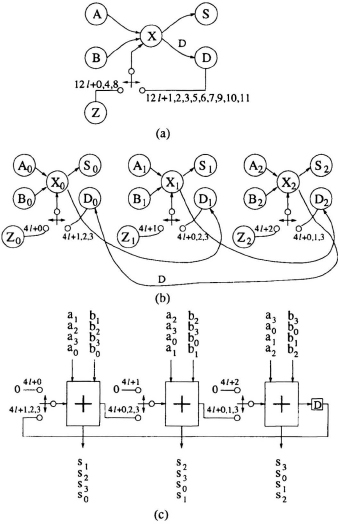5.7 PROBLEMS
- Unfold the DFG in Fig. 5.20 using unfolding factors 3 and 4.
- Unfold the DFGs in Fig. 5.21 using unfolding factors 2 and 5.
- Prove the relationship in (5.3) used to show that unfolding preserves the number of delays.
- This problem attempts to show that a complex loop, which is a combination of 2 simple or fundamental loops, cannot introduce a new iteration bound. To show this, consider two loops with loop computation times T1 and T2, respectively, and with number of delay elements N1 and N2, respectively. Let T1/N1 > T2/N2 hold. Show that

- Our objective in this problem is to prove that the critical path of a J-unfolded DFG is a monotonically nondecreasing function with respect to J [11]. To show this, prove that the critical path of a J-unfolded DFG is greater than or equal to the critical path of the (J − l)-unfolded DFG.
- Prove that the following iterative algorithm computes the minimum unfolding factor for a nonrecursive DFG such that the iteration period of T is achievable. It is assumed that pipelining and/or retiming are not used to reduce the critical path.
Repeat until Tcrit ≤ JT
{


Fig 5.19 (a) The DFG in Fig. 5.16 redrawn so it is compatible with the unfolding ...
Get VLSI Digital Signal Processing Systems: Design and Implementation now with the O’Reilly learning platform.
O’Reilly members experience books, live events, courses curated by job role, and more from O’Reilly and nearly 200 top publishers.

